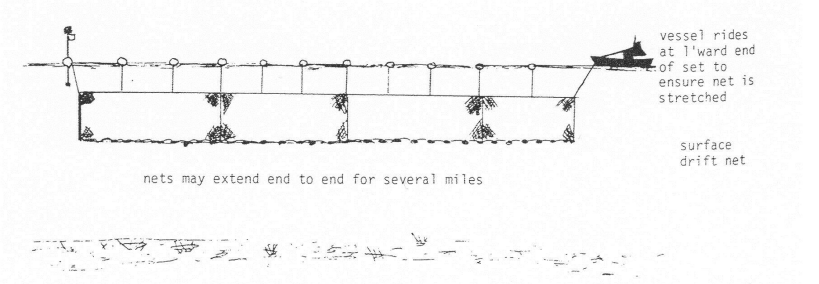On the nets used by drifters in a largely abandoned, but sustainable method of catching herring now developed unsustainably elsewhere
DRIFT OR GILL NETTING
Drifting involves a set of nets hanging vertically like a mesh wall, but not anchored to the sea bed. The nets, shot from fishing boats which unsurprisingly became known as ‘drifters’ or even ‘herring drifters’, are suspended in a line from corks or buoys and weighed down below by a heavy rope.

The herring is a pelagic or midwater species. During the day, they feed on or near the seabed. Following the plankton they rise to the surface at sunset, sink halfway down at midnight then come up again at dawn.
Drift netting is a passive method of fishing – you shoot the nets and wait for the herring to swim up into them. The size of mesh greeting them is designed to catch the adults by the gills (hence the alternative name of gill netting) whilst allowing juveniles to swim through and escape.
The origins of the basic technique are lost in the mists of time, but it was considerably developed by the Dutch in the rise of their Groote Visserye (Grand Fishery) in the C15th. They record the first large herring net having been made at Hoorn in 1416.
The large net was required because of their development of the Herring Buss, an early factory ship, catching, gutting, salting and storing the fish on board. It was this which enabled their exploitation of herring grounds off the English and Scottish coasts.
Drifters were gradually replaced on the West Coast of Scotland by the ring netters from the middle of the C19th. As these spread to the East Coast, they were already being replaced in the North Sea and elsewhere by purse seining, the technologies of which were pioneered in the USA. Each development created a more efficient and less sustainable fishery.
The Scottish and English East Coast fleets largely stuck with drifters through until the 1950s and 60s. They were fully aware of the long term threat to livelihoods from the increasingly accurate shoal finding technology and the increasingly indiscriminate nets. It’s always hard to argue with profits, however.
Whilst drift netting was a sustainable way of catching herring, as populations declined the line of nets got longer and longer. Mechanical hauling overcame the limits that had previously been imposed by human endurance.
In other fisheries around the world, the lines of drift nets became even longer – up to thirty miles and more, creating in turn their own indiscriminate walls of death.
